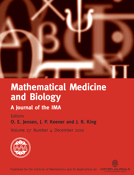-
Views
-
Cite
Cite
Adrian Maler, Frithjof Lutscher, Cell-cycle times and the tumour control probability, Mathematical Medicine and Biology: A Journal of the IMA, Volume 27, Issue 4, December 2010, Pages 313–342, https://doi.org/10.1093/imammb/dqp024
Close - Share Icon Share
Abstract
Mechanistic dynamic cell population models for the tumour control probability (TCP) to date have used a simplistic representation of the cell cycle: either an exponential cell-cycle time distribution (Zaider & Minerbo, 2000, Tumour control probability: a formulation applicable to any temporal protocol of dose delivery. Phys. Med. Biol., 45, 279–293) or a two-compartment model (Dawson & Hillen, 2006, Derivation of the tumour control probability (TCP) from a cell cycle model. Comput. Math. Methods Med., 7, 121–142; Hillen, de Vries, Gong & Yurtseven, 2009, From cell population models to tumour control probability: including cell cycle effects. Acta Oncol. (submitted)). Neither of these simplifications captures realistic cell-cycle time distributions, which are rather narrowly peaked around the mean. We investigate how including such distributions affects predictions of the TCP. At first, we revisit the so-called ‘active–quiescent’ model that splits the cell cycle into two compartments and explore how an assumption of compartmental independence influences the predicted TCP. Then, we formulate a deterministic age-structured model and a corresponding branching process. We find that under realistic cell-cycle time distributions, lower treatment intensities are sufficient to obtain the same TCP as in the aforementioned models with simplified cell cycles, as long as the treatment is constant in time. For fractionated treatment, the situation reverses such that under realistic cell-cycle time distributions, the model requires more intense treatment to obtain the same TCP.





